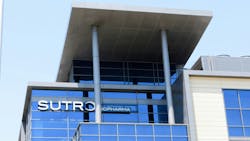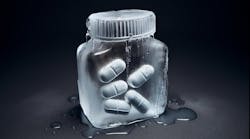Sutro to exit internal GMP manufacturing facility by end of 2025 as part of restructuring
Under a major restructuring, South San Francisco-based Sutro Biopharma has decided to slash its headcount by nearly 50% and wrap up operations at its internal GMP manufacturing facility in San Carlos, California by the end of 2025.
As part of its reorganization, Sutro has “deprioritized” additional investment in lead asset luvelta — a Tubulin FRα-targeting antibody-drug conjugate (ADC) — that was being developed to treat cancer patients. The company will instead focus on three preclinical programs in its next-generation ADC pipeline for oncology. Sutro said the manufacturing capabilities to support the pipeline “have been fully established and scaled up externally.”
In January, Sutro and Boehringer Ingelheim announced they successfully scaled Sutro’s proprietary cell-free protein synthesis platform to a commercial level, producing luvelta in 4,500-liter batches at Boehringer Ingelheim’s facility in Vienna, Austria, and meeting GMP standards required for clinical use.
“That was intended to become a commercial manufacturing site for us had we taken the [luvelta] program all the way to commercialization,” Venkatesh Srinivasan, chief technical operations officer at Sutro, told Pharma Manufacturing. “We have a very deep relationship with Boehringer Ingelheim now, and we can anticipate that other products may also go in there when they reach the appropriate stage of manufacture.”
As part of its “externalizing” of manufacturing capabilities, Sutro is ceasing operations at its own internal GMP manufacturing facility in San Carlos, according to new CEO Jane Chung, who replaced Bill Newell earlier this month. Chung told Pharma Manufacturing that a “large portion” of the positions being eliminated in the 50% headcount reduction either worked on luvelta or at the San Carlos site.
“San Carlos was really built for extract manufacturing on a smaller scale, so we’ve outgrown that facility in terms of what our products will need moving forward,” Chung said.
The leased San Carlos site, which includes two buildings, has been used primarily to manufacture Phase 1 and Phase 2 clinical material for Sutro using its proprietary cell-free expression technology.
“That site does not manufacture ADCs per se,” Srinivasan said. “It’s primarily a microbial facility in which we do the front end of our cell-free platform.” Antibodies and cell-free components are manufactured at the facility, which are “then sent out to a CDMO to put the ADC together,” he noted.
Cell-free protein technology
Conventional ADCs are made using Chinese hamster ovary (CHO) cells, while Sutro’s XpressCF cell-free protein synthesis platform enables the precise design of a wide range of features that the company contends are not possible with other platforms. According to Sutro, the production of proteins using its cell-free system can be scaled rapidly from sub-1mL to manufacturing scale.
Chung said the company’s cell-free technology is “unlike the CHO-based manufacturing system that requires a cell production line” that takes about 18 months to complete, while the XpressCF platform provides “high-throughput” and very rapid screening.
“Within 72 hours, you can actually iterate and see so many different possibilities of the protein that you’re trying to make,” according to Chung. “It feeds currently our early pipeline of ADCs. We don’t have an interest of actually selling the technology per se, but we can share the licensing, share access to the technology should companies be interested in other therapeutic areas.”
The platform is highly flexible in terms of its ability to make all different kinds of large molecules beyond just antibodies, including vaccines. Vaxcyte, a clinical-stage vaccine company, has licensed the platform from Sutro to re-engineer the way it makes highly complex vaccines through modern synthetic techniques.
“It remains a Sutro intellectual property and we’re open to considering various relationships with respect to that IP,” Srinivasan said. “We’re willing to license that out to potential partners for discovery. In addition, if somebody wants to take that technology and then use it for manufacturing other kinds of proteins, outside of the space of Sutro’s direct interest, we’d be interested in entering into those kinds of conversations.”






